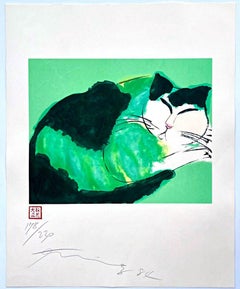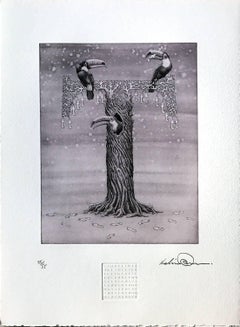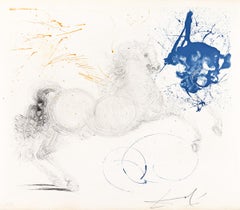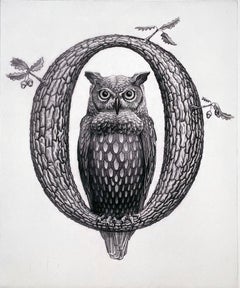Aquatint Animal Prints
1980s Pop Art Aquatint Animal Prints
Ink, Pencil, Graphite, Etching, Aquatint
2010s Contemporary Aquatint Animal Prints
Etching, Aquatint
1930s Art Deco Aquatint Animal Prints
Paper, Pencil, Aquatint
1960s Surrealist Aquatint Animal Prints
Color, Engraving, Etching, Aquatint
1830s Victorian Aquatint Animal Prints
Watercolor, Engraving, Aquatint, Intaglio
2010s Contemporary Aquatint Animal Prints
Etching, Aquatint
Early 19th Century Naturalistic Aquatint Animal Prints
Aquatint
2010s Contemporary Aquatint Animal Prints
Etching, Aquatint
Early 19th Century Naturalistic Aquatint Animal Prints
Aquatint
Early 19th Century Naturalistic Aquatint Animal Prints
Aquatint
2010s Contemporary Aquatint Animal Prints
Aquatint, Etching
Early 19th Century Naturalistic Aquatint Animal Prints
Aquatint
Early 19th Century Naturalistic Aquatint Animal Prints
Aquatint
1890s Impressionist Aquatint Animal Prints
Etching, Aquatint
2010s Contemporary Aquatint Animal Prints
Etching, Aquatint
2010s Contemporary Aquatint Animal Prints
Etching, Aquatint
Mid-20th Century Impressionist Aquatint Animal Prints
Aquatint
2010s Contemporary Aquatint Animal Prints
Etching, Aquatint
1930s Modern Aquatint Animal Prints
Drypoint, Aquatint, Etching
1980s Contemporary Aquatint Animal Prints
Etching, Aquatint
20th Century Modern Aquatint Animal Prints
Drypoint, Aquatint
1970s Aquatint Animal Prints
Aquatint, Etching
20th Century Modern Aquatint Animal Prints
Drypoint, Aquatint
1790s Old Masters Aquatint Animal Prints
Engraving, Paper, Etching, Aquatint
1970s Aquatint Animal Prints
Aquatint, Etching
20th Century Modern Aquatint Animal Prints
Drypoint, Aquatint
1970s Abstract Expressionist Aquatint Animal Prints
Engraving, Drypoint, Etching, Aquatint, Mixed Media, Pencil, Graphite
1980s Pop Art Aquatint Animal Prints
Mixed Media, Etching, Aquatint, Pencil, Graphite
20th Century Modern Aquatint Animal Prints
Drypoint, Aquatint
20th Century Modern Aquatint Animal Prints
Drypoint, Aquatint
2010s Contemporary Aquatint Animal Prints
Metal, Iron
20th Century Modern Aquatint Animal Prints
Aquatint, Drypoint
2010s Contemporary Aquatint Animal Prints
Etching, Aquatint
20th Century Modern Aquatint Animal Prints
Aquatint, Drypoint
20th Century Modern Aquatint Animal Prints
Drypoint, Aquatint
20th Century Modern Aquatint Animal Prints
Aquatint, Drypoint
20th Century Modern Aquatint Animal Prints
Drypoint, Aquatint
1950s Modern Aquatint Animal Prints
Aquatint, Etching
20th Century Modern Aquatint Animal Prints
Drypoint, Aquatint
20th Century Modern Aquatint Animal Prints
Aquatint, Drypoint
20th Century Modern Aquatint Animal Prints
Aquatint, Drypoint
20th Century Modern Aquatint Animal Prints
Drypoint, Aquatint
20th Century Modern Aquatint Animal Prints
Aquatint, Drypoint
20th Century Modern Aquatint Animal Prints
Drypoint, Aquatint
20th Century Modern Aquatint Animal Prints
Aquatint, Drypoint
20th Century Modern Aquatint Animal Prints
Drypoint, Aquatint
1970s Surrealist Aquatint Animal Prints
Drypoint, Paper, Aquatint
2010s Academic Aquatint Animal Prints
Etching, Aquatint, Paper
2010s Aesthetic Movement Aquatint Animal Prints
Paper, Mulberry Paper, Mezzotint, Etching, Aquatint
1970s Surrealist Aquatint Animal Prints
Drypoint, Aquatint, Paper
1970s Surrealist Aquatint Animal Prints
Drypoint, Paper, Aquatint
1970s Surrealist Aquatint Animal Prints
Drypoint, Paper, Aquatint
1970s Surrealist Aquatint Animal Prints
Drypoint, Paper, Aquatint
1970s Surrealist Aquatint Animal Prints
Drypoint, Paper, Aquatint
1970s Surrealist Aquatint Animal Prints
Drypoint, Paper, Aquatint
1970s Surrealist Aquatint Animal Prints
Drypoint, Paper, Aquatint
1970s Surrealist Aquatint Animal Prints
Drypoint, Paper, Aquatint
1970s Surrealist Aquatint Animal Prints
Drypoint, Aquatint, Paper





